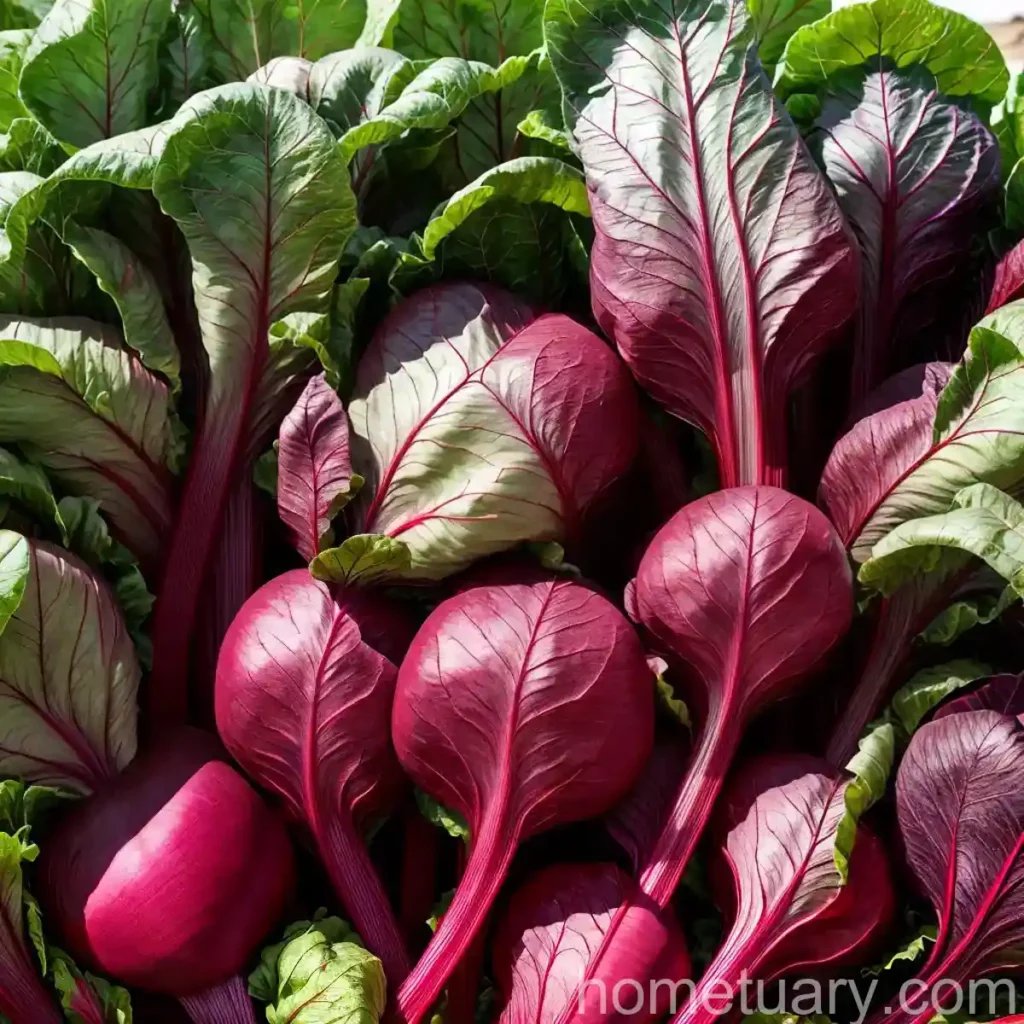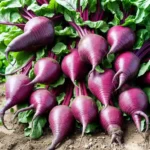Swiss Chard (Beta vulgaris (Leaf Beet Group))
Swiss chard, also known as leaf beet or silverbeet, is a leafy green vegetable that is not only delicious, but also a beautiful addition to any garden. In this blog post, we will discover the culture, uses, and tips for growing Swiss chard. From its health benefits to the varieties available, we will explore everything you need to know about this versatile and nutritious plant.
What is Swiss Chard?
Swiss chard (Beta vulgaris (Leaf Beet Group)) is a leafy green vegetable that belongs to the same family as beets and spinach. It is known for its large, dark green leaves and colorful stalks, which can be red, yellow, pink, or white. Swiss chard is a biennial plant, but it is typically grown as an annual for its edible leaves.
Key Takeaways
- Swiss chard belongs to the leaf beet group of the Beta vulgaris species.
- It is a leafy green vegetable known for its large, dark green leaves and colorful stalks.
- Swiss chard is versatile, nutritious, and can be grown in various climates and conditions.
Culture
Swiss chard is a versatile plant that can thrive in different climates and growing conditions. Here are some key factors to consider when cultivating Swiss chard:
Water
Swiss chard requires consistent moisture to thrive. It is important to water the plants regularly, especially during dry periods, to prevent the soil from drying out. However, it is also essential to avoid overwatering, as excessive moisture can lead to root rot and other diseases.
Sunlight
Swiss chard prefers full sun but can also tolerate partial shade. In hot climates, providing some shade during the hottest part of the day can help prevent the leaves from wilting.
Fertilizer
When planting Swiss chard, it is beneficial to enrich the soil with organic matter, such as compost or well-rotted manure. Additionally, a balanced fertilizer can be applied during the growing season to support healthy growth and abundant leaf production.
Soil
Swiss chard grows best in well-draining, fertile soil with a slightly acidic to neutral pH. Amending the soil with organic matter can improve its texture, moisture retention, and nutrient content.
Pruning
While Swiss chard does not require extensive pruning, removing any damaged or yellowing leaves can promote continuous growth and overall plant health.
Uses
Swiss chard is a versatile vegetable that can be used in a variety of culinary applications. From its nutritional value to its flavorful leaves and stems, Swiss chard is a welcome addition to any kitchen. Here are some common uses of Swiss chard:
-
Culinary Uses: Swiss chard can be enjoyed raw in salads, sautéed, steamed, or added to soups, stews, and stir-fries. The tender leaves and crisp stems provide a delightful contrast in both flavor and texture.
-
Nutritional Benefits: Packed with vitamins, minerals, and antioxidants, Swiss chard is a nutritious addition to any diet. It is low in calories and high in fiber, making it a healthy choice for various dietary preferences.
Propagation
Swiss chard can be propagated from seeds or transplants. When planting from seeds, sow them directly into the ground or start them indoors and transplant the seedlings once they have developed a few true leaves. Swiss chard seeds germinate best in soil temperatures ranging from 50°F to 85°F.
Container Popularity
Due to its compact growth habit, Swiss chard is well-suited for container gardening. It can be grown in pots, planters, or raised beds, making it an excellent choice for urban gardens, balconies, and small spaces.
Container Common Diseases
When growing Swiss chard in containers, it is important to watch out for common diseases such as leaf spot, powdery mildew, and downy mildew. Providing adequate air circulation and avoiding overhead irrigation can help prevent these issues.
Disease Diagnosis
If you notice any signs of disease on your Swiss chard plants, such as discolored or spotted leaves, it is essential to diagnose the problem early. Identifying the specific disease can help you implement the appropriate control measures, such as removing affected leaves, adjusting watering practices, or applying organic fungicides if necessary.
Common Pests
Swiss chard is relatively resistant to pests, but it can occasionally be affected by aphids, flea beetles, and leaf miners. Regular monitoring of the plants and the use of physical or organic pest control methods can help manage these issues effectively.
Botanist’s Tips
As a plant scientist, I have some valuable tips for growing and enjoying Swiss chard:
-
When harvesting Swiss chard, select the outer leaves while allowing the inner leaves to continue growing. This practice encourages continuous leaf production throughout the growing season.
-
Interplanting Swiss chard with aromatic herbs, such as dill, mint, or cilantro, can help deter pests and attract beneficial insects to the garden.
Fun Facts
Here are some fascinating facts about Swiss chard:
-
Swiss chard is also known as “silverbeet” in some regions, referring to the silvery sheen on the surface of its leaves.
-
The colorful stems of Swiss chard can range from vibrant red and orange to sunny yellow and pale white, adding visual interest to the garden and the plate.
Links to External Resources
For more information on Swiss chard, explore the following resources:
- Swiss Chard Recipes
- Swiss Chard Nutrition
- How to Grow Swiss Chard
- Swiss Chard Health Benefits
- Swiss Chard Varieties
- Swiss Chard Planting Guide
- Swiss Chard Care Tips
- Swiss Chard Harvesting
- Swiss Chard Growing Season
- Swiss Chard Cooking Methods
- Swiss Chard Soil Requirements
- Swiss Chard Companion Plants
- Swiss Chard Pests and Diseases
- Swiss Chard Leaf Colors
- Swiss Chard Leaf Texture
- Swiss Chard Watering Needs
- Swiss Chard Sunlight Requirements
- Swiss Chard Container Gardening
- Swiss Chard in Raised Beds
- Swiss Chard in Hydroponics
- Swiss Chard in Vertical Gardens
- Swiss Chard for Beginners
- Swiss Chard for Urban Gardens
- Swiss Chard in Small Spaces
- Swiss Chard for Edible Landscaping
- Swiss Chard for Sustainable Gardening
- Swiss Chard as a Superfood
- Swiss Chard and Heart Health
- Swiss Chard for Weight Loss
- Swiss Chard for Detoxification
- Swiss Chard for Bone Health
- Swiss Chard for Immune System Support
- Swiss Chard for Digestion
- Swiss Chard and Anti-inflammatory Properties
- Swiss Chard Recipes for Kids
- Swiss Chard Smoothies
- Swiss Chard Salads
- Swiss Chard Soups
- Swiss Chard Stir-fry Recipes
- Swiss Chard Appetizers
- Swiss Chard Side Dishes
- Swiss Chard for Juicing
- Swiss Chard Pickling
- Swiss Chard Storage Tips
- Swiss Chard Freezing Methods
- Swiss Chard Canning
- Swiss Chard in Mediterranean Cuisine
- Swiss Chard in Asian Cuisine
- Swiss Chard in Mexican Cuisine
In conclusion, Swiss chard is a delightful and nutritious addition to any garden. Its vibrant leaves and stems, along with its versatility in culinary applications, make it a must-have for both beginner and experienced gardeners. Whether you are growing it in a garden bed, raised bed, or container, Swiss chard is a rewarding plant that offers a continuous harvest throughout the growing season. With its numerous health benefits and delightful flavors, Swiss chard is a valuable addition to any home garden or kitchen.
Happy gardening and cooking with Swiss chard!















